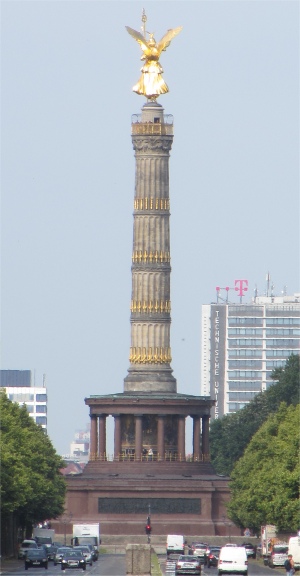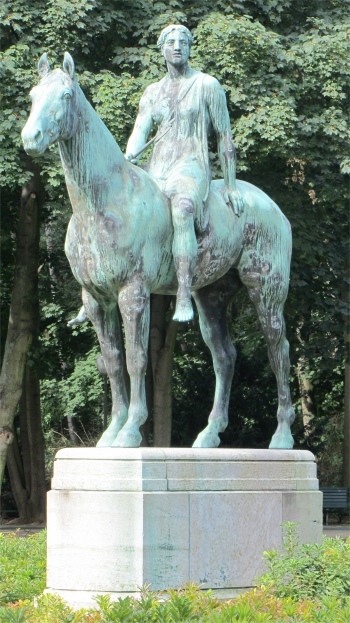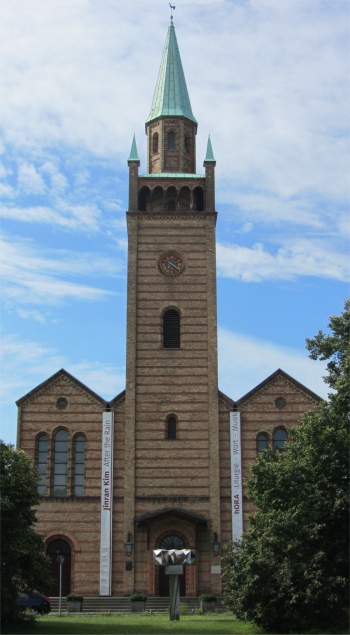
St. Matthäus-Kirche
|
Immediately in front of me, as if greeting me into this cultural world, was the Berliner Philharmonie, home to the Berlin Philharmonic Orchestra, a building acclaimed for both its acoustics and its architecture. It was built in 1960-63 to replace the old Philharmonie, destroyed by British bombers on 30th January 1944, the eleventh anniversary of Hitler becoming Chancellor. The hall is a singular, yellow building, asymmetrical and tent like, with the main concert hall in the shape of a pentagon.
Standing back to the east of the Philharmonie a large glass flying saucer shape loomed up to the sky, the Sony Centre. Immediately on the southern side of the Philharmonie stood another yellow building, the Kammermusiksaal (The Chamber Music Hall), architecturally and musically the little brother of the Berlin Philharmonie. Its tent-like shape and centrally positioned podium for the musicians reflect the concept of the "big" Philharmonie. As a venue for the many chamber music groups of the Berliner Philharmoniker, it presents the multifarious artistic activities of the members of the orchestra beyond their symphonic work.
Even further south, the tower of the St. Matthäus-Kirche proudly looked out over this musical centre. A soulless wasteland of concrete, actually a vast car park containing a scattering of trees and huge rocks in front of the musical complex, rather let down the setting. On the western side of this concrete sprawl, another mass of concrete reared up. This was in reality a collection of modern museums.
I headed across there, and climbed a series of steps and sloping flagstones, which I thought must be a real whizz in icy conditions, stood below a large sign, "EINGANG", the entrance to the Gemäldegalerie, the Kunstbibliothek, the Kupferstichkabinett, and the Kunstgewerbemuseum.
The Kunstgewerbemuseum (Museum of Decorative Arts) is the oldest of its kind in Germany. It houses world-famous examples of European arts and crafts, including magnificent reliquaries made of gold and precious gemstones, exquisite vases of glass and porcelain, finely embroidered textiles, ornate inlaid furniture, and classic examples of modern industrial design.
The Kupferstichkabinett (Museum of Prints and Drawings) is home to a universe of 'art on paper,' with masterpieces by Sandro Botticelli, Albrecht Dürer, Rembrandt, Adolph Menzel, and Vincent van Gogh, Ernst Ludwig Kirchner and Pablo Picasso, and - more recently - Andy Warhol and Gerhard Richter. With its wealth of treasures, it is a central place for European artistic ideas, images, and forms of expression, as well as for those of world cultures linked to Europe through cultural and historical ties. It contains works from 1000 years of the history of art, culture, and the media, ranging from the Middle Ages to the present day. The museum's collection comprises a staggering 550,000 prints and some 110,000 drawings, watercolours, pastels, and oil sketches.
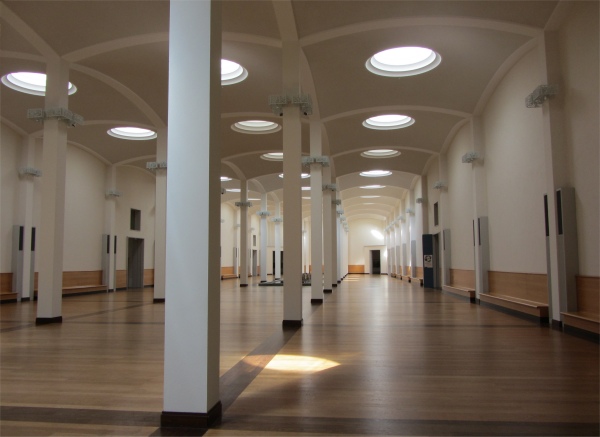
Gemäldegalerie Central Hall
|
The Kunstbibliothek is one of the largest museum libraries dedicated to all facets of art history and cultural studies. Above and beyond this, however, it also boasts valuable collections on the history of architecture, photography, graphic design, fashion, book art, and media art. Its extremely diverse vast holdings include works in a wide variety of media: first editions and historical postcards, illustrated placards and posters, fashion designs, architectural drawings and models, bequests of photograph collections, and Fluxus assemblages. Together, the library and the various museum collections it contains represent the full spectrum of source material on the history of art.
I would not have time to visit them all, so my intention was to visit the Gemäldegalerie - eventually! A few souls sat in huddles around the area just outside the large entrance to all these museums. I marched up to the entrance only to discover that it did not open until 11am on Saturdays. So I too formed my one man huddle waiting for the museums to open. By 11am there was a whole camp of huddles congregated outside the museums, patiently waiting. However, in Germany if would not matter how many huddles were waiting, the rules state that doors will not open until 11am precisely. "Vee have vays of opening doors". At 10:59, we were all on our feet waiting by the doors.
Without further ado I headed straight for the Gemäldegalerie section of the complex. The paintings in the Gemäldegalerie collection have been on show in their present home at the Kulturforum since 1998. The design proposals for the Gemäldegalerie's new building were submitted in an architectural competition in 1986, with the contract awarded to the architects Hilmer & Sattler the following year. With distinctly Prussian austerity of expression, the simple building rises above the sloping piazzetta, while inside its individual galleries are grouped around a light-filled central hall. After the collapse of the Berlin Wall and the subsequent remerger of the Staatliche Museum zu Berlin in 1991, the Gemäldegalerie was expanded with the addition of a study gallery.
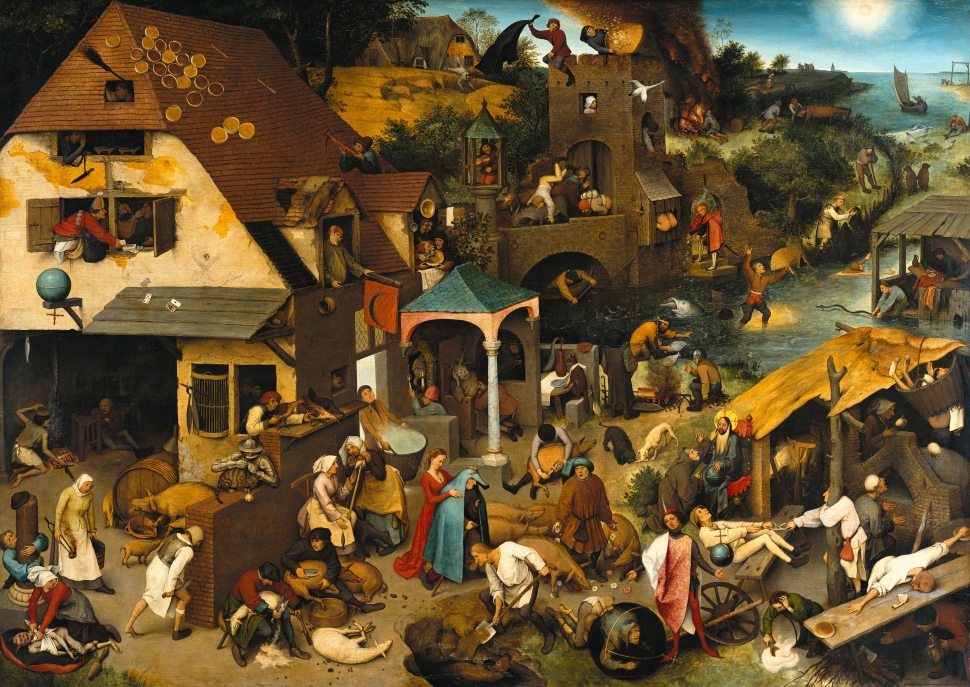
Bruegel's "Netherlandish Proverbs" Containing Approximately 112 Identifiable Proverbs
|
In its sense of architectural restraint, the simple designs of the façade are deliberately reminiscent of Karl Friedrich Schinkel's Altes Museum. And in keeping with this, the individual galleries within demonstrate a classical sense of proportion. From the large central hall, conceived as a place of quiet reflection with indoor fountains designed by Walter De Maria, visitors can weave their way through the galleries at leisure, dipping in and out on their personal tour through the collection. I found this large, airy, peaceful and well-lit central hall a delightful place to enter, and contemplate on what I had just seen before moving on to the next room.
The Gemäldegalerie boasts one of the world's most important collections of European painting ranging from the 13th to 18th century. Masterpieces from all epochs in the history of art are on permanent display here, including paintings by Jan van Eyck, Pieter Bruegel, Albrecht Dürer, Raphael, Titian, Caravaggio, Peter Paul Rubens, Rembrandt, and Jan Vermeer van Delft. The gallery is especially proud of its strong collection of German and Italian paintings from the 13th to 16th century and paintings from the Low Countries dating from the 15th to 17th century.

German Chancellery
|
Of particular delight, since we had seen a copy earlier in our travels, was a 1559 work by the Flemish artist Pieter Bruegel the Elder,
Netherlandish Proverbs, that depicts a scene in which humans and, to a lesser extent, animals and objects, offer literal illustrations of Dutch language proverbs and idioms cataloguing human folly. His son, Pieter Brueghel the Younger, specialised in making copies of his father's work and painted at least 16 copies of Netherlandish Proverbs. Not all versions of the painting, by father or son, show exactly the same proverbs and they also differ in other minor details. There are approximately 112 identifiable proverbs and idioms in the scene, although Bruegel may have included others which cannot be determined. Some of those incorporated in the painting are still in popular use, for instance "Swimming against the tide", "Banging one's head against a brick wall" and "Armed to the teeth", and there are some that are familiar if not identical to the modern English usage such as "casting roses before swine". Many more have faded from use or have never been used in English. "Having one's roof tiled with tarts", for example. I love all Bruegel paintings because of the stories they tell, and the glimpses into life in the 16th century.
The gallery was excellent, and having undergone a superb art fix, I hiked back to the train station to meet Dan. His train arrived a little late, unusual for Germany, but it was good to see him again. He gave me a big smile, followed by an even bigger hug - what a great son he is.
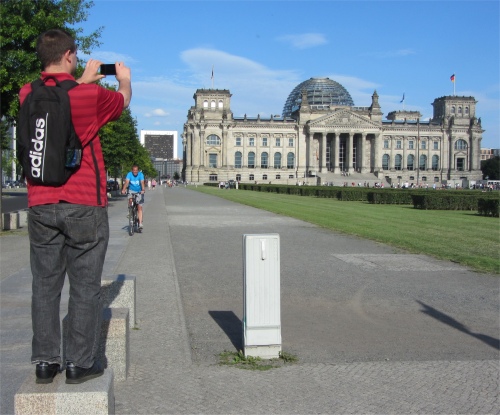
Dan Captures the Reichstag
|
We briefly caught up on some news before he set about showering and freshening himself up. He had set off for Berlin straight after work on Friday night, caught the Eurostar to Brussels where he grabbed a few hours sleep before catching an early train to Berlin.
Then it was a wander down to the grassy bank overlooking the Spree, where we took in refreshments and spotted tourist boats. Lo and behold, one went by, and there on the deck of one, frantically waving to us, was Meryl. We just chilled out there under the warm sun until Rex and Meryl joined us for a drink and chat.
In the evening we managed to catch part of an "Open Air Theatre" Multimedia presentation, a daily light show projected onto the wall of the Marie-Elisabeth-Lueders-Haus on the other side of the Spree opposite the Reichstag. The show concerned itself with the Imperial period late 19th century on parliamentary development in the Weimar Republic. Through the darkest period after the seizure of power by the National Socialists, moving films showed the division of Germany right through to the completion of German unity up into the present. The film traced how the Reichstagsgebaude built during this period as a parliamentary seat, was destroyed, reconditioned, and was then veiled and rebuilt to eventually become the all-German parliamentary seat that would revive the late nineties again. A neat presentation I thought.
After the show, Dan and I strolled along by the river side, which was magically lit by millions of lights from surrounding buildings, and the occasional cruise boat silently gliding by, though one was not so silent, with a disco in full swing inside. The air was still warm, and the city very vibrant. Dan and I rounded off the day off nicely with a beer in the hotel bar and a chin wag afterwards.
